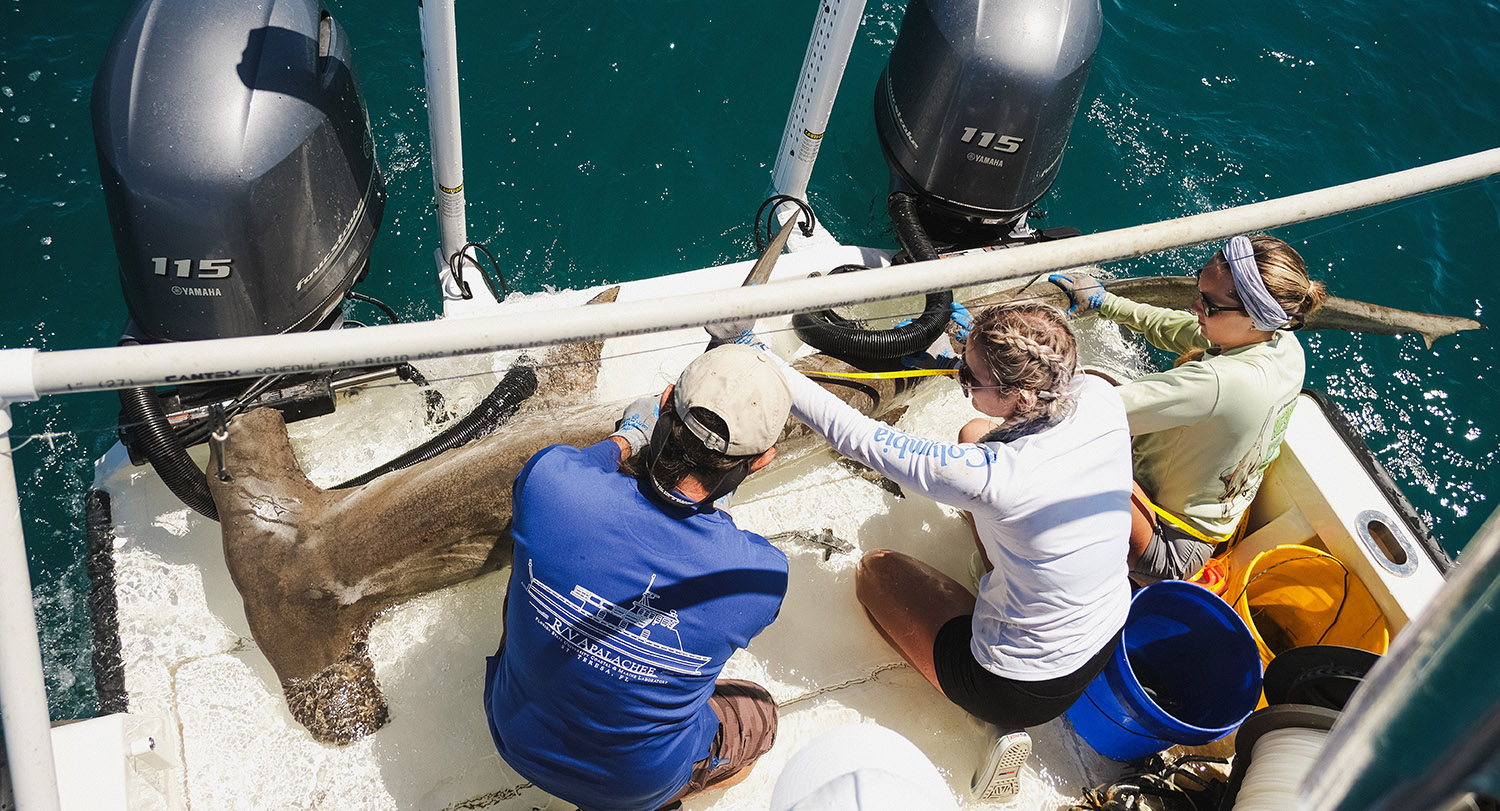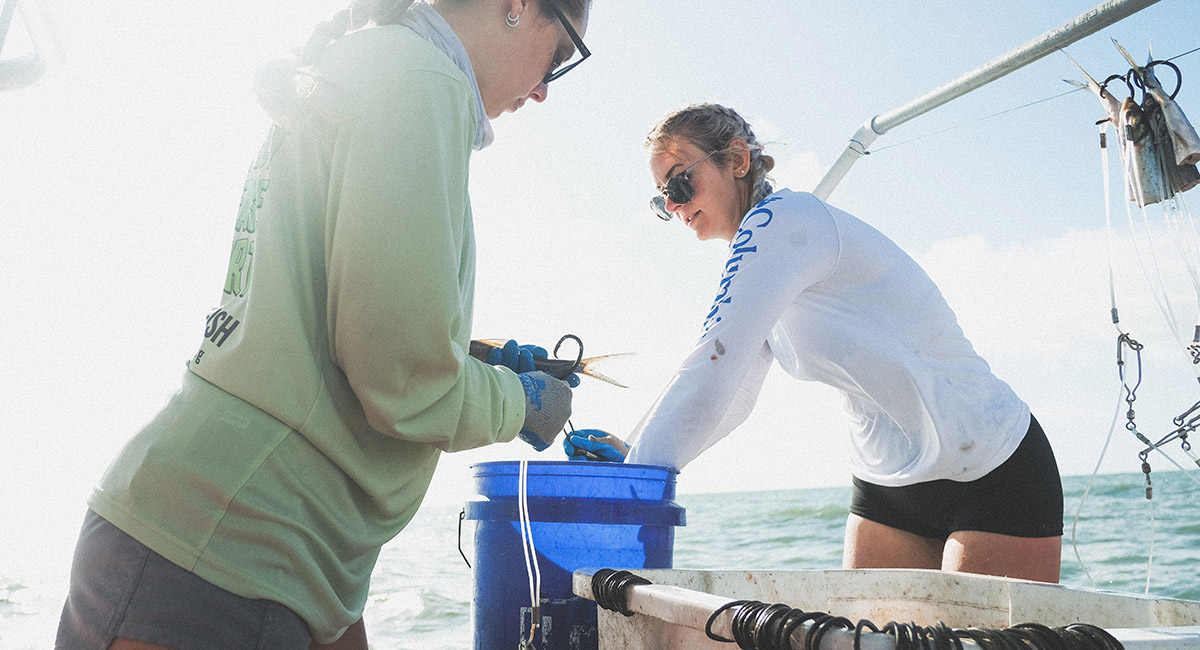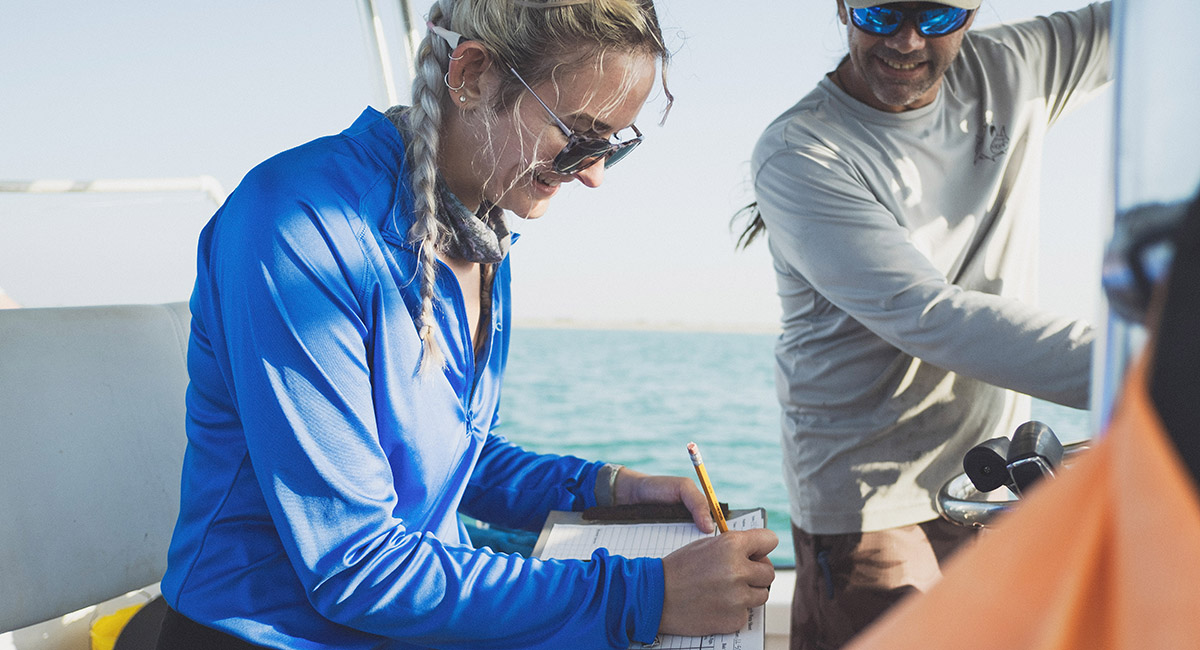
For Emma Jackson, every week is shark week
Hollings scholar and marine science grad researches sharks, rays, anything else that swims her way
Five researchers combine their strength to lift a thrashing shark onto their boat. One secures the shark’s head – taking care to avoid injuring the specimen and being scraped by the shark’s abrasive skin – and the rest of the team works with an efficiency rivaling the most experienced pit crews.
There are fins to be measured, tracking tags to be placed, blood to be drawn, data to be recorded. All the while, water floods the deck, the sun blazes overhead and, oh yeah, they’re wrangling a shark in the Gulf of Mexico.
It all happens in 2 minutes. “And then we send them on their way,” says Emma Jackson with a smile, as if she’s just described something as mundane as unloading a dishwasher.
That’s because Jackson is not afraid of sharks. She’s fascinated by them – and, more importantly, she’s trained to handle them safely. The 2023 Capstone Scholar alumna and 2021 NOAA Hollings scholar has been preparing for field work like this since she enrolled at the University of South Carolina. Jackson, who earned her degree from USC in marine science, is now a biological sciences Ph.D. student at Florida State University, pursuing her passion for elasmobranchs: the subclass that includes sharks, rays and sawfish.
Casting a wide net
Growing up in St. Peters, Missouri, Jackson could only dream about the opportunities she’s now experiencing. She visited Chicago’s Shedd Aquarium as a child and “fell in love with the stingrays because they had a little touch pool.”
That encounter sparked an interest in biology and marine science, as well as the desire to study in a coastal state. She also “fell in love” with USC when she visited, and the Capstone Scholars program provided a supportive community.
Jackson wanted to study sharks at USC, but that research wasn’t happening on campus. Instead, she joined Claudia Benitez-Nelson’s marine geochemistry lab, studying nutrients in water columns. “None of it’s related to sharks,” she says, “but it gave me all the foundation I needed.”

It also gave her the confidence to apply to a shark and ray field camp in Tampa. “I learned how to long line, and I learned how to gillnet there, and I was able to begin identifying species local to the Tampa Bay region,” she says. “It was so invaluable, because that’s the kind of stuff I do now. I didn’t know it back in the time – I was like, ‘This is so much work. It’s so hard. I don’t want to do it.’ But I realized with that experience: OK, field work is great. It’s fun to be out on the boat. It’s fun to work with sharks, gather all the data.”
But Jackson didn’t just want to collect data; she wanted to share it. This passion for collecting and communicating environmental research made her an excellent candidate for the NOAA Hollings Scholarship, which she earned her sophomore year. The scholarship provides $19,000 for academic expenses and a paid summer internship that provides scholars with hands-on, practical experience in a NOAA-related field. More than 70 USC students have received the prestigious national scholarship since it was started in 2005.
Jackson knew she wanted to work with sharks, and her tenacity led her to the National Marine Fishery Service in Panama City Beach, Florida, and she spent her Hollings Scholarship summer internship analyzing sandbar sharks’ stomach contents. A change in the sharks’ eating habits could alert scientists to other changes in the marine ecosystem, and since COVID-19 had led to a backlog of specimens, Jackson was encouraged to study as many as possible. “Honestly, it was really fun,” she says. “I loved it.”
The school of fish
In her Ph.D. program, Jackson is just as busy on dry land as she is on the research boat. She’s working on publishing her findings from her NOAA internship, gathering data for her dissertation on deep-sea sharks, rays and fish, and teaching undergraduate science courses.
“A lot of students are like, ‘I think you were more excited about (class) than I was. But your excitement made me excited,’” she says.

Jackson also strives to foster a sense of community. “Our little (grad student) cohort has been complimented on being the most involved and friendly to one another and just excited about everything,” she says, “I honestly feel like, because I led a little bit of that organization. . . I feel like I can attribute that to Capstone.”
If any team needs to be cohesive, it’s a team handling sharks. Fieldwork begins early, around 6 a.m., as the team prepares the boat and inventories their supplies. They’re in the water by 7:30, attaching bait to lines and gearing up for a long day of surveying the gulf, taking an oceanic inventory for NOAA’s annual report.
The days are long, but Jackson’s excitement hasn’t dimmed. “You never know what’s going to swim into it or get caught on the line,” she says. “It’s always really exciting to pull it up and be like, ‘OK, what is it?’”
As for post-Ph.D. plans, Jackson is ready for whatever swims her way, though her dream is to conduct research for a government agency such as NOAA. “I want to make connections,” she says, “to people going into the policy field so that way we can work together.”
In the meantime, she’s excited to “dive into my Ph.D.” (the pun is all hers) and continue fostering appreciation for sharks, rays and their aquatic companions.
“Seeing the diversity of sharks and rays is incredible. They come in all different shapes and sizes, and even just being able to see one in the wild is absolutely captivating. And until you get to see them in their natural habitat, I feel like you don’t get the full appreciation for them. There’s a lot of different reasons to be fascinated.”
Learn more about sharks this week
Some of Jackson’s recommended resources for learning all about elasmobranchs are:
All research activities conducted under ESA permit 22078 and SAL 1345
National Fellowships and Scholar Programs provides support for NOAA Hollings Scholarship applicants. Students interested in learning more should contact USC’s national fellowships team.
Photos: Lloyd Wilkinson